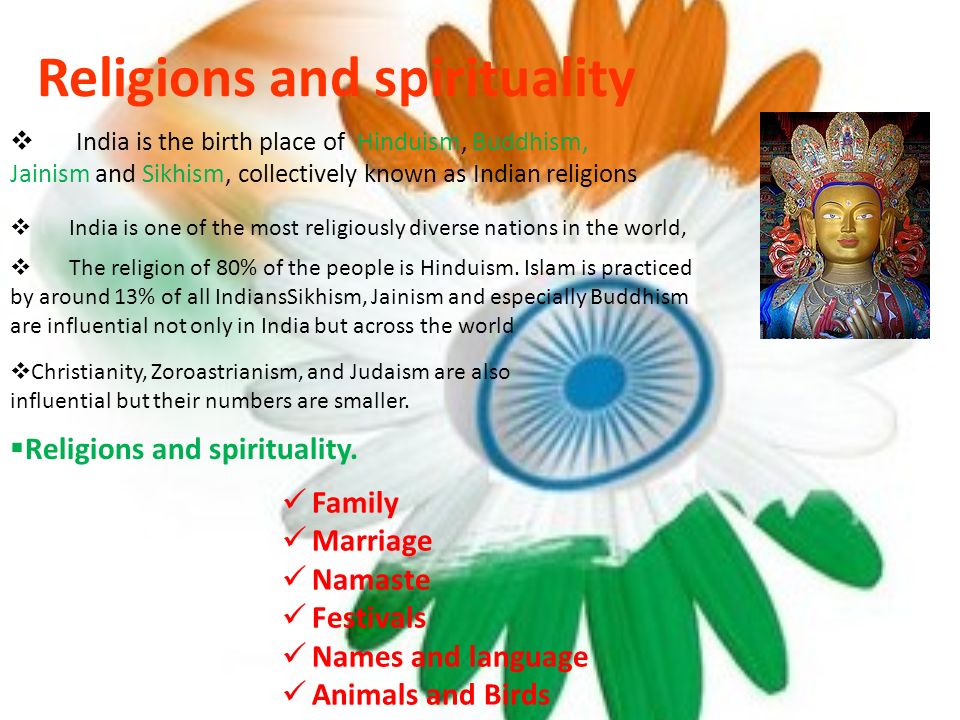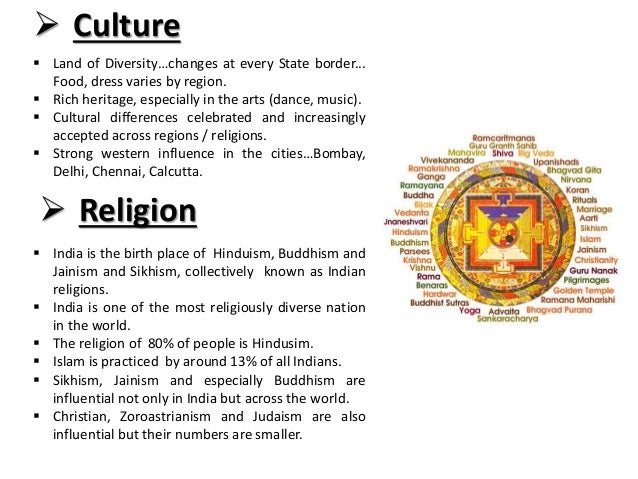Religions in India
Relevance: Prelims/Mains: G.S paper I: Art and Culture
INTRODUCTION

Religion in India is characterized by a diversity of religious beliefs & practices. Secularism in India means treatment of all religions equally by the state. India is a Secular State by the 42nd amendment act of Constitution in 1976. The Indian subcontinent is the birthplace of four of the world’s major religions; namely Hinduism, Buddhism, Jainism and Sikhism.
Throughout India’s history, religion has been an important part of the country’s culture. Religious diversity and religious tolerance are both established in the country by the law and custom; the Constitution of India has declared the right to freedom of religion to be a fundamental right.
Christianity
- Two major divisions – the Roman Catholic Church and the Protestant church.
- According to tradition, Christianity was brought to India by Saint Thomas in the 100 A.D.
- to legends, the Parthian king Gondophernes sent a messenger to Syria to look for a skilful architect who would build for him a new city, who returned with St. Thomas, who converted him and many members of his court to Christianity.
- The truth of the legend is doubtful. It was most probably the frequent trade and movement between India and the west which was responsible for bringing this disciple of Lord Christ to India.
- Tomas preached Christianity in many parts of India & was killed at Mylapore, near Madras. The tomb of St. Thomas is still to be found at the same place.
- A large community of Christians known as Syrian Christians continues to reside in Kerala even today
Sikhism
- Started by Guru Nanak & was preached by subsequent gurus till tenth Guru, Guru Gobind Singh; with basic beliefs as:
- Formless god
- Equality of all mankind
- Need of a Guru
- Pahul tradition
- Music has always been an important feature of Sikhism as they believe that through music one can attain ecstacy or samadhi.
- The fifth guru, Guru Arjun Dev, gave the Sikhs three things viz.
- Adi Granth, which contains the sayings of five gurus and other allied saints
- Standardized script for Gurmukhi in which the Adi Granth was first written
- Site and the foundation of the Har Mandir sahib / Golden Temple and the Akal Takht at Amritsar, the highest seat from where the dictats for the entire Sikh community are issued.
- The tenth guru, Guru Gobind Singh created the Khalsa, which means “the pure”, in 1699.

- He also ordained the Sikhs to take five vows, namely, keeping of kesh (long hair and a beard), kangha (comb), kada (a metallic bangle), kirpan (a sword) and kaccha (an underwear extending to a little above the knees). Consequently, these symbols became the distinguishing marks of a Sikh.
- He further added that after his death the Adi Granth will be the guru of the Sikhs and they have to pay obeisance to this holy book.
Zoroastrianism
- Founded by Zarathushtra or Zoroaster, in 8th century BC. He preached monotheism in the region now known as Persia
- He taught the worship of fire + the presence of good and bad in the form of Ahura Mazda (the Supreme Being represented as a deity of goodness and light) and Ahura Man
- Zoroastrian religion spread over the whole of Persia and remained the dominant religion till the 8th century AD when Muslims conquered this region.
- Most of the Parsis migrated to different parts of the world. They also came to India and settled at Navsari in Gujarat, and later on spread to almost all the parts of India.
- Zoroastrianism is not a proselytizing religion and no new entrants are accepted into its fold under any circumstances.
Sufism & Islam
- According-to the Muslim belief, Quran is the message of Allah revealed to Mohammad through his archangel Gabriel.
- Prophet Mohammad’s sayings are preserved in what is called the Hadith or Hadees.
- The five fundamental principles of Islam are:
- Tauhid (belief in Allah)
- Namaz (prayers, five times a day)
- Roza (fasting in the month of Ramzan)
- Zakat (giving of alms)
- Haj (pilgrimage to Mecca)
- Sufism originated in Iran and found a congenial atmosphere in India under the Turkish rule; preached spirituality through music mainly.
- In order to attain a state of mystical ecstasy, the sufis listened to poetry and music (sama) which were originally in Persian, but later switched to Hindawi or Hindustani.
- Sufi saints such as Moinuddin Chisti, Nizamuddin Auliya, Fariduddin Ganj-e-Shakar were the pioneer sufïs who are still loved, respected and honored in India.
- Sufis were also influenced by the Christian and Buddhist monks regarding the establishment of their khanqahs and dargahs
- Khanqah – institutions (abode of Sufis) set up by the Sufis in northern India took Islam deeper into the countryside.
- Mazars (tombs) and Takias (resting places of Muslim saints) also became the centers for the propagation of Islamic ideas.
- Sufis were organized into religious orders or silsilahs. According to Abul Fazl, the author of the Ain-i-Akbari, there were as many as 14 silsilahs in India during the sixteenth century.
- Each order had its own khanqah, which served as a shelter for the Sufi saints & for destitute, and later developed as a center of learning
- A pir nominated a successor or wali from his disciples to carry on his work.
- Sufis organized samas (a recital of holy songs) to arouse mystical ecstasy. These also started the tradition of piri-muridi, (teacher and the disciple).
Bhakti Movement
- In northern India, it developed into two streams, nirguna bhakti and saguna bhakti.
- Nirguna bhaktas – Devotees of a formless God even while calling him variously as Rama, Govinda, Hari or Raghunatha. The most conspicuous among them were Kabir and Nanak
- Saguna bhaktas – Devotees of Rama, the son of Dasharatha, or Krishna, the son of Devaki and Vasudeva
- Tulsidas, who idolised Rama in his famous Ramcharita Manas
- Surdas, who sang praises of Krishna in his famous
- Raskhan, a Muslim poet, who was a devotee of Lord Krishna, also belonged to this tradition.
The use of terms such as Krishna, Radha, Gopi, Jamuna, Ganga etc. became so common in medieval literature that an eminent Sufi, Mir Abdul Wahid wrote a treatise Haqaiq-i-Hïndi to explain their Islamic equivalents.
One of Kabeer’s doha conveyed that if by worshipping a stone (idol) one could attain God, then he was willing to worship a mountain. It was better to worship a stone flour-grinder because that could at least fill stomachs.
Similar to ideas of the Sufis, came logic of guru or spiritual teacher, whose function was to provide people with hope, strength and inner courage. He was supposed to be a person who had marched ahead on the path of bhakti and had probably realized God and hence was capable of leading others into Him.
This brought in a system of pahul. Pahul was the sanctified water offered by a master to the pupil or shishya as a token of his being accepted as a trainee on his march to godliness
The Sikhs performed “washing of the swords” ceremony, called khande ka pahul, evolving as the pir-muridi custom (the saint-soldier concept).
Judaism
- Indian Jews are a religious minority of India. Judaism was one of the first foreign religions to arrive in India.
- Of the total Jewish population in India, about half live in Manipur & Mizoram and a quarter live in the city of Mumbai.
- In Kerala a community of Jews can be seen at Kannur (Kodungalloor) and Kochi
BAHA’I Faith
- Youngest of the world’s independent religion. India was the 6th country to have the Baha’i Faith introduced to it. Very small %age of population in India follows Baha’i Faith.
- Baha’i House of worship in Delhi, popularly known as the Lotus Temple is a prominent attraction in Delhi. It was completed in 1986 and serves as the mother temple of the Indian subcontinent.
Vaishnavism & Shaivism in South India
Vaishnavism
Panini’s Ashtadhyayi worshippers of Vasudeva (Krishna) Vasudeva-Bhagavata cult Vishnu (primarily an aspect of sun) & Narayana (cosmic God) Gupta period Vaishnava bhakti cult + doctrine of incarnations (avataras) Vaishnava saints (Vishnu) known as Alvars in Tamil + songs called Prabandhas Shaivism
- Unlike Vaishnavism, Saivism had its origin in antiquity
- Panini refers to a group of Shiva worshippers as Shiva-bhagavatas
- Shiva Bhakts are characterized by the iron lances and clubs they carried and their skin garments
- Shaiva Bhakt in Tamil → Known as Nayanars which hails from all castes
- Songs called Tevaram Stotras / Dravida Veda
- Prominent Shaiva movements → Agamanta, Shudha and Vira-shaivism
For more such notes, Articles, News & Views Join our Telegram Channel.
Click the link below to see the details about the UPSC –Civils courses offered by Triumph IAS. https://triumphias.com/pages-all-courses.php

